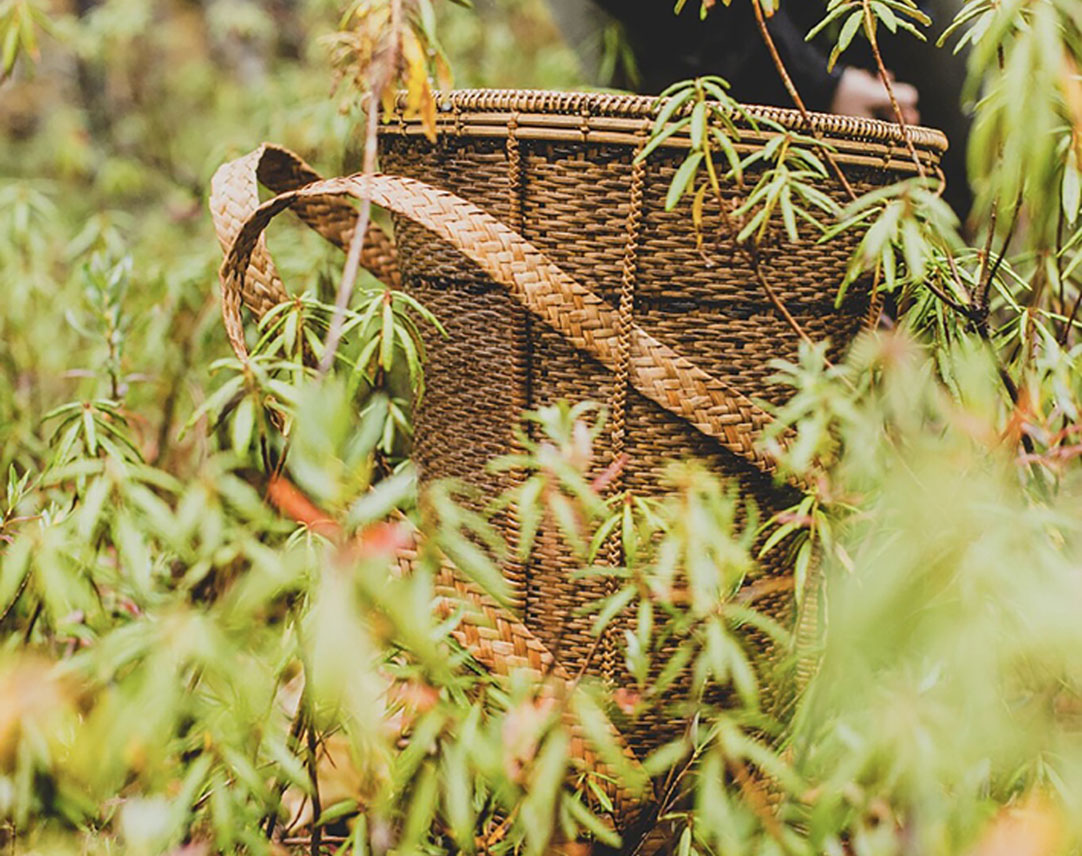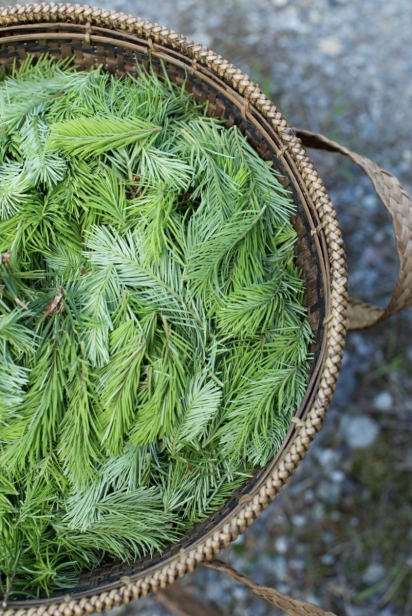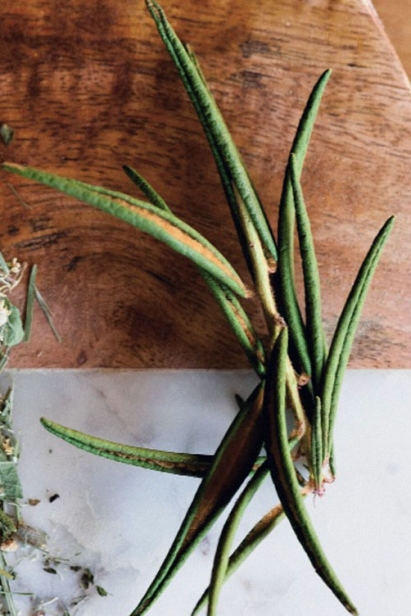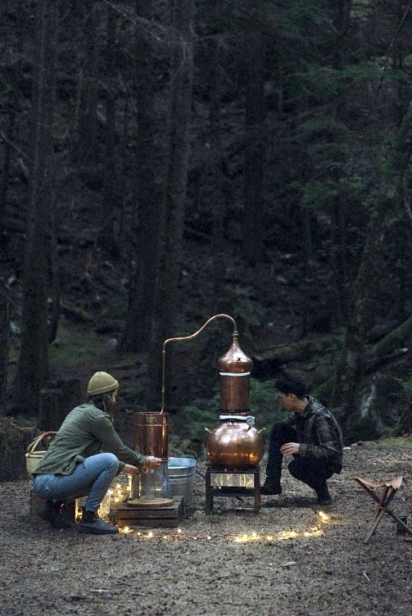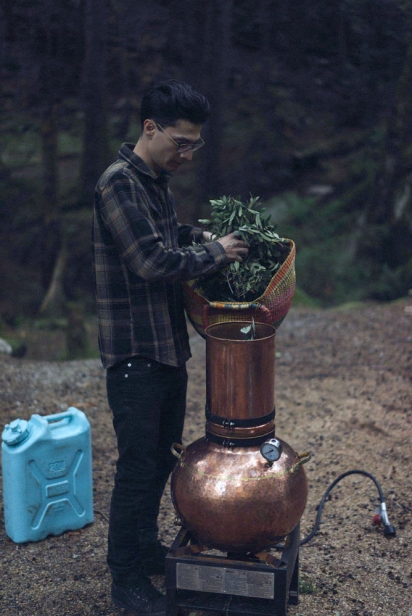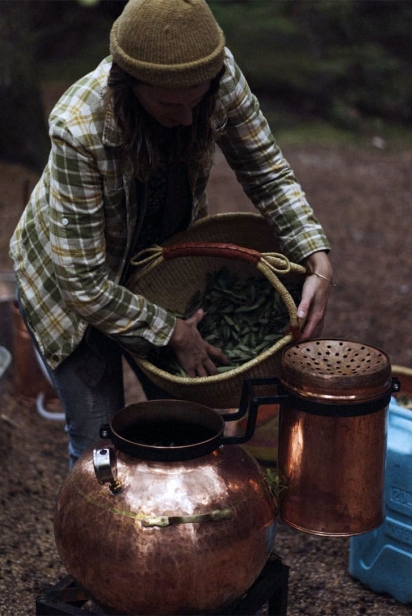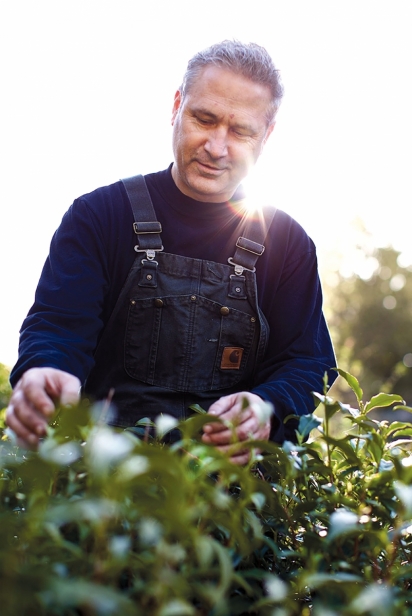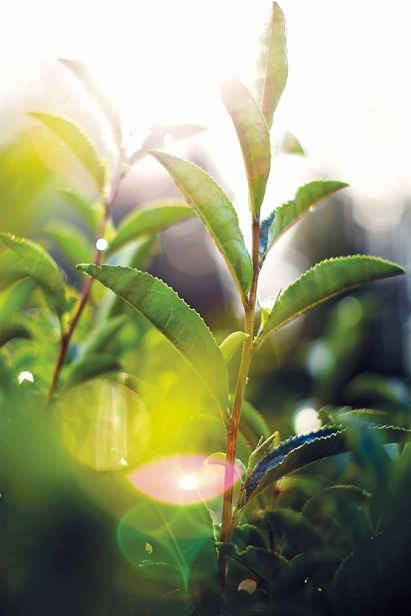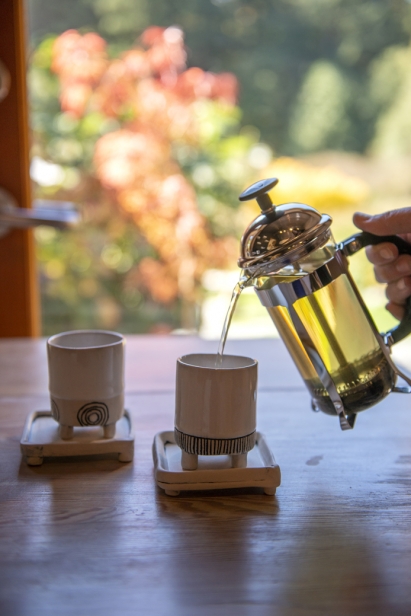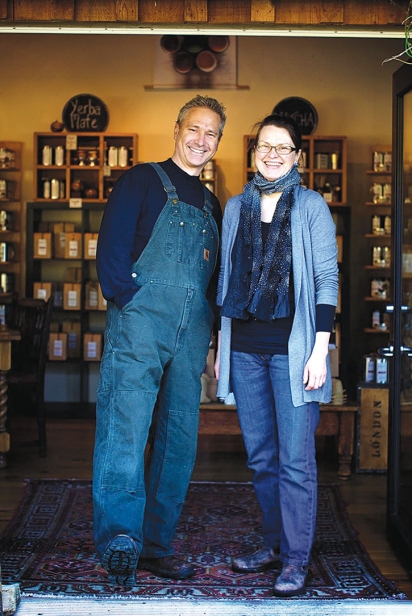Tea: Farmed and Foraged
Early morning as the forest mist rises around Whistler, Isabelle Ranger, founder and owner of Namasthé Tea Co., and her partner Cédric Gervais, can be found talking to the plants.
Their regular foraging walks, which Isabelle calls, “the easy part,” can take anywhere from a few hours to an entire day. It’s a purposeful and deliberate pursuit immersed in a tradition of patient respect.
Ranger forages for her teas here throughout the spring and fall seasons. Once winter arrives and covers the plants with a snowy blanket, she’ll still venture out, putting on her snowshoes and exploring the forest floor to collect cones and bark.
Her reverence towards plants started early. As a child, she would camp with her family in Québec and learned through the tutelage of older women to identify safe plants to eat, including the brightest red Wintergreen berries and the sticky sap of milkweed.
This initial interest led her to study herbalism under Medical Herbalist Rowan Hamilton on her journey towards becoming a master tea crafter. Her teas at Namasthé Tea Co., so named as a play on words to honour her French-Canadian heritage and her interest in yoga and Indian culture, are now sold online and through many stores and cafés across British Columbia and Canada.
Ranger also has proud Labrador Inuit heritage and strong ties to the Lil'wat First Nation in Whistler, B.C. Ancient wisdom and Indigenous teachings have informed the way in which she forages for herbs and plants. This includes never taking more than a quarter of a plant and nurturing a deep and lasting relationship with the land.
“A lot of teachings go into how to pick, when to pick, which ones to pick. To make sure that you actually are caretaking those patches, so whatever plant stands are there, you go back every season and they're healthier. You're helping them propagate, you're helping them grow and thrive. You're not just taking. It's a connection. It's a relationship, you're a caretaker of those plants,” she says.
Foraging in this way is non-negotiable for Ranger and Gervais, but it certainly isn’t the easiest or quickest way to operate. “You process it twice, as you're picking it and again, as you're drying it. It's a very slow process, but you end up with a beautiful, final product that you can use in teas,” she says.
That slow process starts in the forest and continues with series upon series of quality-control measures. Ranger is always thinking about sustainability, for the plants and the forest in general. Things don’t end up in her basket by accident, everything is purposefully gathered with care.
Showing respect for the plants she uses means that Ranger does indeed ask the forest for permission to forage and harvest from the land. She explains that this tradition differs for everyone, but can include making contact with the plant, giving it a hug, a word of thanks or even an offering of tobacco or a song.
Asking for consent also means that she has to accept that sometimes permission is not given. “It's something that you just feel. Sometimes you'll walk up to certain plants and get a distinct feeling of ‘no’ and you respect that,” she says.
Ranger and Gervais forage up and down the sea-to-sky country with fall being their busiest time. The most time-intensive part of the hand-foraging process for Ranger is after the harvest. She must sort through all her treasures, completing those second and third and fourth quality-control measures and preparing the plants and herbs for drying.
This commitment to respecting the natural world that provides so much to us all is central to Ranger’s internal philosophy. It’s who she is as a person, rather than just a marketing tactic. In fact, it’s often in conflict with her needs as a business owner.
“As a business, to me, it's not always growth for growth. It has to follow the vision mission and has to be right in my heart and it has to be as sustainable as possible,” she says.
You may have already tasted the delicious tea from Namasthé Tea Co. and not even realized it. Perhaps it was while visiting the Lil'wat cultural centre or sipping the Scandinavian tisane while relaxing at the Whistler Scandinave Spa.
Ranger finds that her caffeine-free teas are very popular along with the old favourites such as Earl Grey. Her chai teas and blends containing turmeric or ginger are also in high demand.
Although Ranger works with a huge array of different plants and herbs, she does have a clear favourite. Labrador tea evokes memories of her Inuit culture and the scent transports her.
“It's got a bit of a feral kind of wild smell and taste to it. The aromatics out of it are amazing. It has a beautiful orange fir under where all the oil glands are and it's just comforting to me. It's also a very traditional tea of my people. Labrador Tea has always been one that's called to me and is really close to my heart. When we're picking it, it just feels like home,” she says.
Namasthé Tea Company
namasthe.ca | @nasmastheteaco
The wildcrafted apothecary
Raphaëlle Gagnon, like Isabelle Ranger, loves to take her basket into the woods and forage for wild herbs and plants. But instead of making teas with her discoveries, she creates hand-crafted bath and beauty products for her label, Boreal Folk.
She wakes to the sounds of the forest, in her baby blue and stainless steel repurposed 1967 transport bus. A pair of rutting stags show off as she prepares for a day of gathering and wildcrafting in the thick of the forest in Northern B.C.
Gagnon’s typical day may sound idyllic to those who dream of escaping the corporate and urban world, but it also comes with its share of hardships. Along with the retro bus, she and her husband, Mark Coelho, also have a trailer that they have turned into a 99-square-foot mobile studio. Coping with freezing pipes in the winter and navigating small living and working areas have challenged Gagnon and Coelho, who have been living an alternative lifestyle since 2015. But they wouldn't change a thing.
“We feel so very privileged to live so close to nature. I’ll be having my coffee in the morning and there are just 20 elks right there. It's definitely something that we love and I don't think we'll ever live in a city,” she says.
The business grew organically, but quickly, from farmers' markets to craft shows, online sales and in stores. This proved tricky at some points when their nomadic lifestyle meant they didn’t have a permanent address to which they could have supplies sent.
The business started out with handmade soaps, face oils and bath salts and now features a full range of face, body and bath products, including lip butter, which is a firm customer favourite and comes in fully biodegradable compostable tubes.
Boreal Folk products are made with locally produced ingredients as much as possible. That includes all those plants and herbs that Gagnon collects outdoors in her forest home as well as Canadian salts from Saskatchewan and locally made beeswax.
Another non-negotiable feature of the brand is a commitment to shunning plastic packaging in favour of biodegradable materials and recyclable glass.
Gagnon describes her labours as “distilling plants and capturing their essence.” It’s a process that relies on intuition informed by experience and years of study.
“Because we've been studying plants for a long time, we knowwhere a plant will be. If we are near a lake for example or a wetland, we know that there will probably be some wild mint growing or Labrador tea, so I'm able to assess the land and guess what I can harvest on that day,” she says.
Like Ranger, Gagnon’s harvesting process is centred on sustainable care.
“We're really going in and pruning, I see nature as my garden, so I walk through the forest, treading very lightly and I'm just pruning certain areas and never uplifting roots,” she says.
Leaving the environment just as she found it is important to Gagnon who in her decade-long career as a tree planter laid down roots to 2.4 million new saplings. The beauty of trees still captures her imagination and she even uses wind-blown branches and boughs as decoration.
The tasks involved in running Boreal Folk are dictated by the season and include set periods for harvesting and collecting wild plants and herbs and then time spent in the laboratory distilling and preserving, creating tinctures, making hydrofoil essential oils and dehydrating plants for later use.
The name for Boreal Folk came to Gagnon when she was living in northern Alberta close to the Northwest Territories. As she reflected on how much she enjoys living and working in Canadian forests and the history of folk herbalism, she settled on the name as a distillation of her experiences planting trees.
“I just loved being in the wilderness and I've always wanted to be so close to nature. My love for the boreal forest has always been there,” she says.
Although Gagnon can possibly see ahead to a time when she will no longer live in a bus, she can’t ever envision moving away from the wilderness that defines her business and her holistic worldview.
“Living so close to nature, you really become connected with the rhythms of the seasons, as they pass, you get to notice things that you wouldn't necessarily in a city. We really like the slow pace of living in the wild,” she says.
Boreal Folk
borealfolk.ca | @borealfolk
Canada's only tea farm
For a truly Canadian experience in your cup, Westholme Tea Company provides all the elements of a homegrown daily ritual. For the past nine years, Victor Vesely and his wife, tea expert and ceramic artist Margit Nellemann, have been perfecting the first 100-per-cent Canadian tea. The terroir of Westholme Tea Company, located in the Cowichan Valley, provides everything tea needs to thrive, which surprisingly can include extremes of heat and cold.
“The tea has not only survived here, but has also developed a very high-quality flavour profile,” he says.
All tea comes from the same plant, Camellia sinensis. It’s the processing and oxidization that determines whether it is a black, white or green tea.
When the two first moved to the area, they grew vegetables, which they sold at farmers’ markets, and quickly realized the potential of their fertile peat low-land soil. However, tea-making is quite the art and for Vesely, it was a process of trial and error.
“There’s not a lot of tea-growing or tea-making in Canada, anybody can grow the Camellia sinensis plant, but not everyone can make high-quality tea, the same way anybody can grow grapes, but not everyone can make wine,” he says.
He is quick to humbly point out that it took him a while to refine his skills and that he is still learning every day. This includes diversifying and being open to additional ways tea can be enjoyed out of the teacup, such as culinary uses, inspired by pickled tea leaves in Myanmar and even creating a pesto of tea leaves.
Westholme Tea Company has also partnered with the local Sheringham Distillery supplying green tea to help create its award-winning Kazuki gin.
Tea-making here is artisanal and hands-on. The couple hasn’t invested in large-scale machinery and Vesely says much of the careful processing of the tea is done by observation and touch.
“It's a different approach. It's less mechanical and scientific, but much more intuitive and that's just my choice in how I'm approaching tea-making,” he says.
Nellemann is the real tea connoisseur, Vesely says, and she is also the creator of unique handmade teacups, saucers and dishes available in the tea store, which are inspired by the different types of tea and by tea culture in general.
“The vessels that Margit creates are integral to improving the flavour profile of the tea and also that overall unique experience,” he says. Westholme's tea, which includes black, white, green, oolong,matcha and herbal varieties, routinely sell out. Vesely credits their success to their commitment to creating a superior product, free of chemicals and pesticides and the inherent health benefits of drinking tea.
However, he knows only too well that what they are growing at Westholme Tea Company is so much more than simply a healthy and delicious beverage.
“Tea is an everyday ritual. The tea leaf represents how it's grown, how it's been lovingly processed and how you need all the elements of nature — earth, water, fire — to prepare it. What ends up in your cup is the closest connection to nature. So, whether you're in a condo in New York or you're sitting in a tea field in India, the opportunity to connect with nature is integral to that ritual,” he says.
That experience includes an appreciation for the fact that tea is a natural product, a plant, and should be enjoyed as close to its natural state as possible.
“We focus on loose-leaf tea so you can see the tea itself — bringing people closer to the idea that it's an agricultural product, that hands actually pluck and process your tea,” he says.
Vesely laments that in North America, people have become disconnected from the sources of their food. At Westholme Tea Company he wants to remind tea drinkers that tea isn’t just another packaged and wrapped commodity, but a chance to enjoy a natural product that also has a social benefit.
“I think tea invites a ritual of connection. That's what we've created here to connect people from all over the world to come and visit and enjoy tea. Tea culture is both a ritual and an integral part of the philosophy of bringing people together,” he says.
At Westholme Tea Company, Vesely and Nellemann are blending tea as well as ancient practice and innovation. “We are a tradition and we won't change that, but we pretty much do it our way,” he says.
Westholme Tea Company
8350 Richards Trail, Duncan, B.C.
westholmetea.com | 1.855.748.3811 | @westholme_tea


